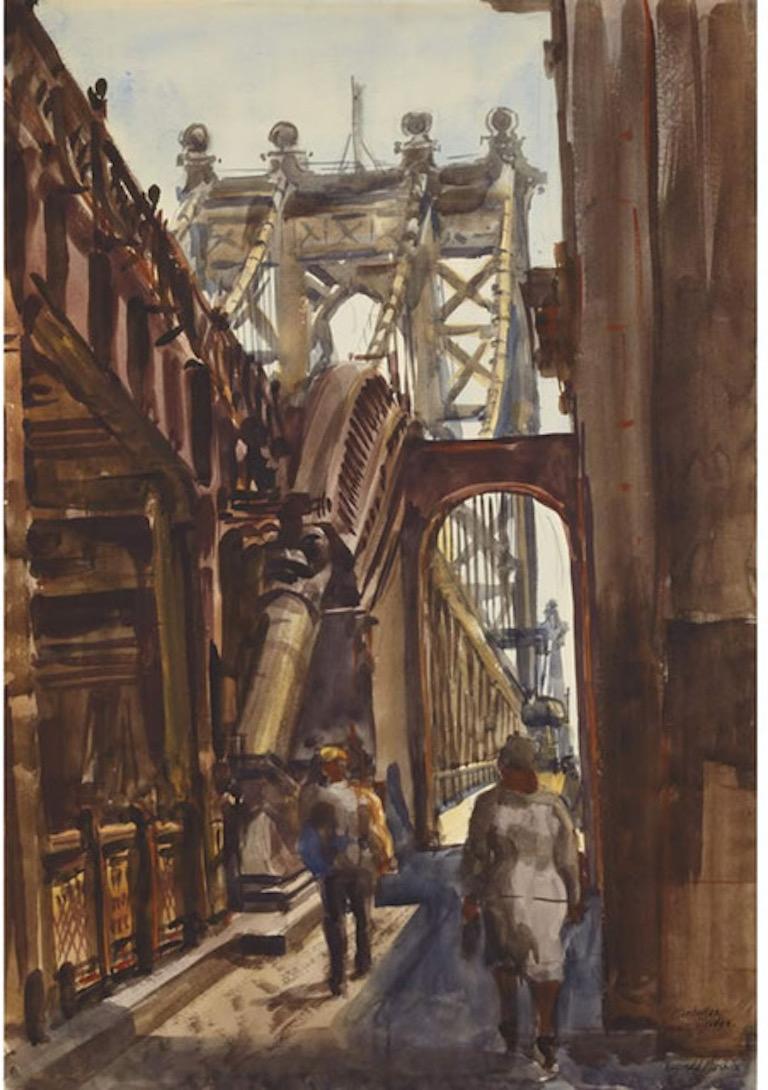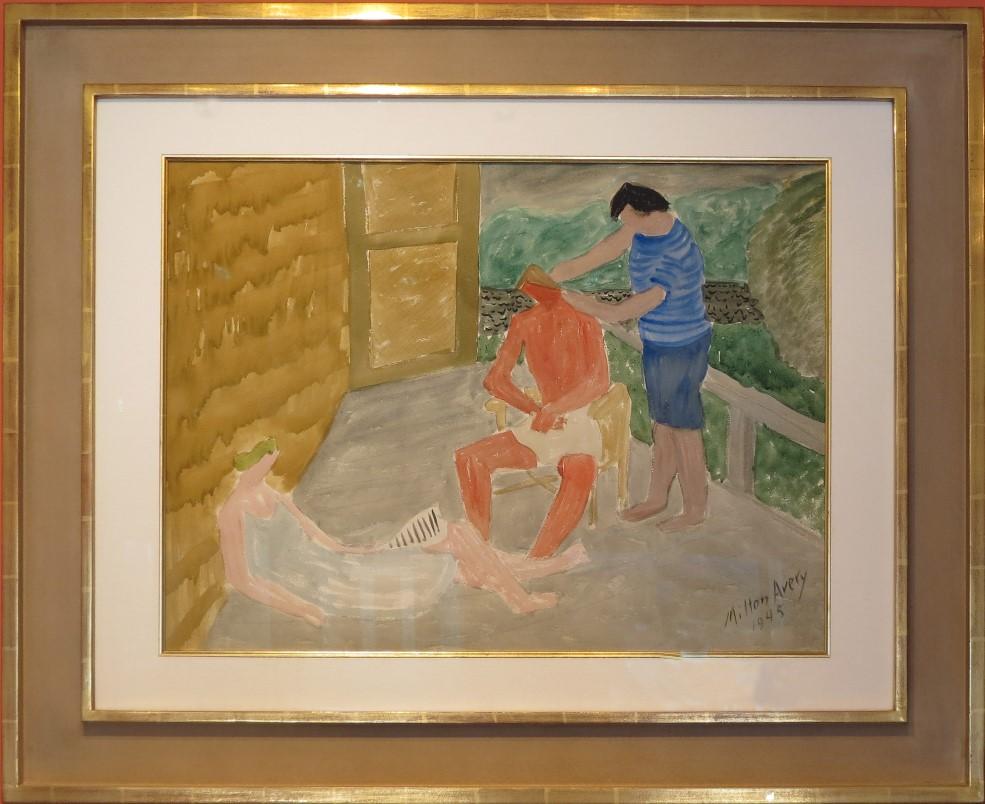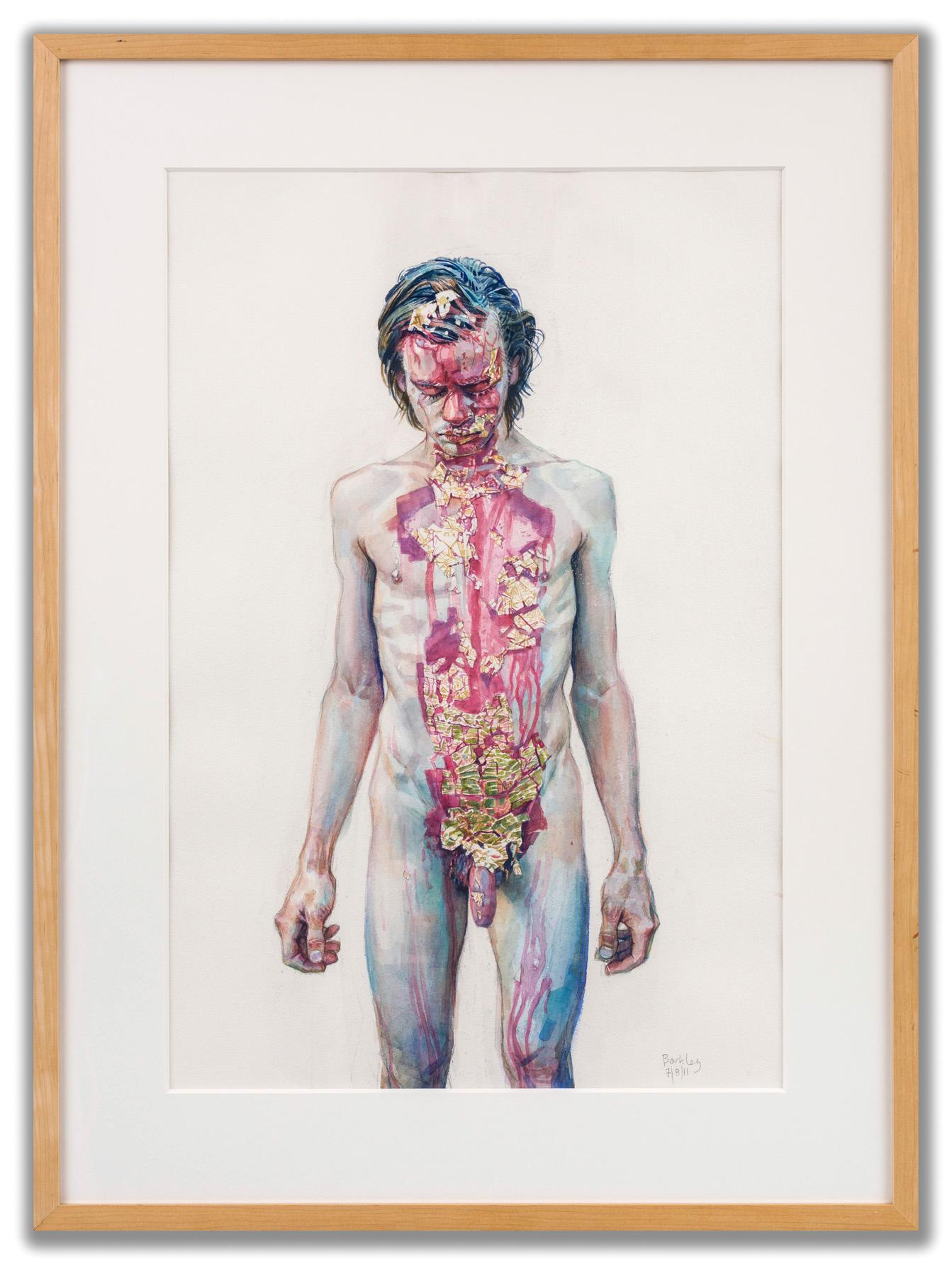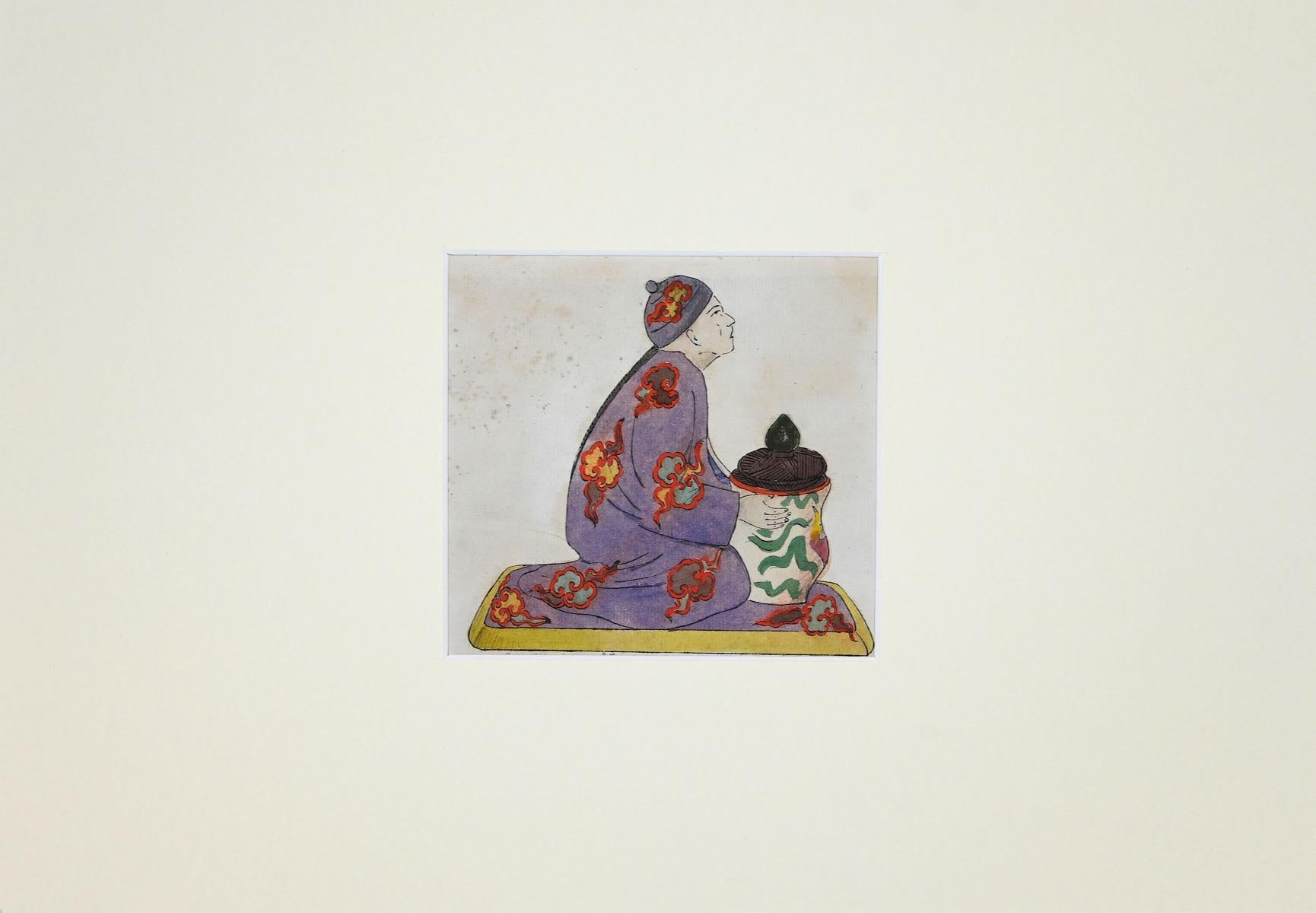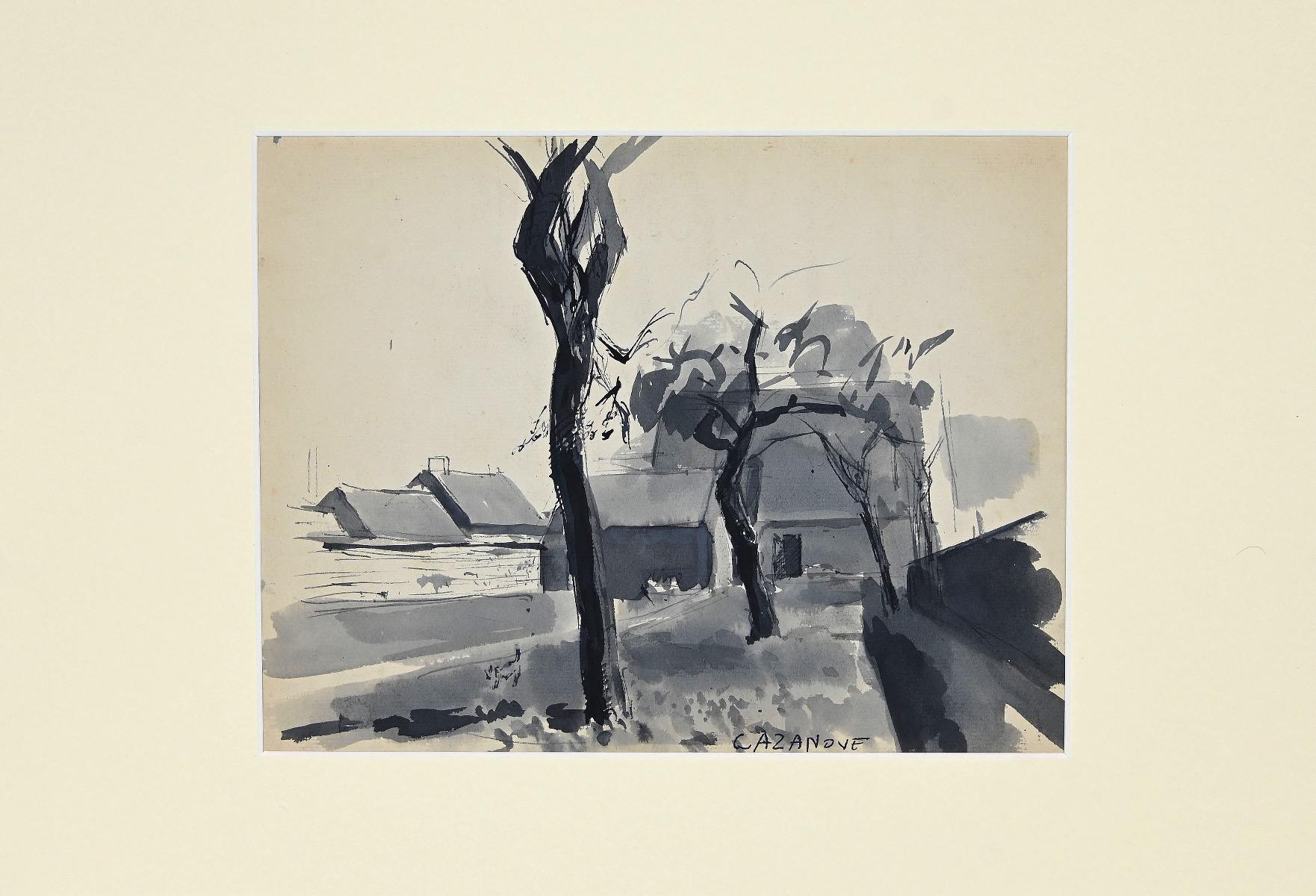Items Similar to Two Men - Watercolor Drawing by Hermann Paul -1890s
Want more images or videos?
Request additional images or videos from the seller
Hermann PaulTwo Men - Watercolor Drawing by Hermann Paul -1890s1890s
1890s
About the Item
Two Men is a Watercolour Drawing realized by Hermann Paul.
Hand signed on the lower right corner.
Good condition.
René Georges Hermann-Paul (27 December 1864 – 23 June 1940) was a French artist. He was born in Paris and died in Saintes-Maries-de-la-Mer.
He was a well-known illustrator whose work appeared in numerous newspapers and periodicals. His fine art was displayed in gallery exhibitions alongside Vuillard, Matisse and Toulouse-Lautrec. Early works were noted for their satiric characterizations of the foibles of French society. His points were made with simple caricature. His illustrations relied on blotches of pure black with minimum outline to define his animated marionettes. His exhibition pieces were carried by large splashes of color and those same fine lines of black. Hermann-Paul worked in Ripolin enamel paint, watercolors, woodcuts, lithographs, drypoint engraving, oils, and ink. Recent efforts to catalog the work of Hermann-Paul reveal an artist of considerable scope.
- Creator:Hermann Paul
- Creation Year:1890s
- Dimensions:Height: 9.73 in (24.7 cm)Width: 12.72 in (32.3 cm)Depth: 0.04 in (1 mm)
- Medium:
- Movement & Style:
- Period:
- Framing:Framing Options Available
- Condition:Insurance may be requested by customers as additional service, contact us for more information.
- Gallery Location:Roma, IT
- Reference Number:
About the Seller
4.9
Platinum Seller
These expertly vetted sellers are 1stDibs' most experienced sellers and are rated highest by our customers.
1stDibs seller since 2017
6,778 sales on 1stDibs
Typical response time: 3 hours
- ShippingRetrieving quote...Ships From: Monaco, Monaco
- Return PolicyA return for this item may be initiated within 14 days of delivery.
More From This SellerView All
- Porcelain Inkwell - Original Ink and Watercolor Drawing - 1890 ca.Located in Roma, ITPorcelain Inkwell is an original china ink and watercolor drawing on ivory-colorated paper by realized in 1890 ca. Anonymous Artist of the late 19th Century. In very good conditions...Category
Late 19th Century Modern Figurative Drawings and Watercolors
MaterialsWatercolor, Paper, Ink
- Figure - Original Watercolor and Pencil by Raymond Cazanove - 1922Located in Roma, ITFigure is an original drawing in watercolor and pencil on ivory paper, realized by Raymond Cazanove in 1922. Hand-signed on the lower margin in ...Category
1920s Modern Figurative Drawings and Watercolors
MaterialsPaper, Pencil, Watercolor
- Portrait - Drawing in Mixed Media on Paper - 1957Located in Roma, ITPortrait is an original drawing in mixed media -ink and watercolor- on paper realized in 1957 by an Anonymous artist of the XX century, Hand-signed on the lower right (unreadable), d...Category
20th Century Modern Figurative Drawings and Watercolors
MaterialsInk, Mixed Media, Paper, Watercolor
- Cityscape - Drawing By Reynold Arnould - 1970Located in Roma, ITCityscape is a Pencil and Watercolour Drawing realized by Reynold Arnould (Le Havre 1919 - Parigi 1980). Good condition. No signature. Reynold Arnould was born in Le Havre, Franc...Category
1970s Modern Figurative Drawings and Watercolors
MaterialsPaper, Pencil, Watercolor
- Landscape with Shepherd - Drawing - 19th centuryLocated in Roma, ITLandscape with Shepherd is a drawing in watercolor and pencil, realized by an Anonymous artist in the late 19th century. Hand-signed, illegible. Good conditions. The artwork is re...Category
19th Century Modern Figurative Drawings and Watercolors
MaterialsPaper, Watercolor
- Au Cimetière Monsieur- Pencil and Watercolor on Paper by F. Picabia - 1931By Francis PicabiaLocated in Roma, ITAu Cimetière Monsieur... is a black pencil and watercolor drawing realized by Francis Picabia in 1931. Hand signed lower left, with title lower right. A certificate of inclusion in the Catalog Raisonné being prepared by the Picabia Committee, dated 30 October 2019, will be delivered in original along with the work. Drawing originally realized by Picabia to illustrate the important volume "Le Peseur d'Ames" by André Maurois, published by Editions Antoine Roche in 1931. Though specifically realized for the volume, the drawing was not selected for publication and remained in the artist's personal collection. Cm. 27,4x22. Good conditions. Francis Picabia (1879-1953) was born in Paris to a french mother and a Spanish father who was chancellor at the Cuban embassy in Paris. He had a comfortable childhood, even though he was emotionally troubled. He studied at the École nationale supérieure des beaux-arts. At the beginning of his career, from 1908 to 1913, he was strongly influenced first by the Barbizon School and by Alfred Sisley and Camille Pissarro, then by impressionism, cubism and finally abstractionism. Around 1911 he joined the Puteaux Group which he met in the studio of Jacques Villon in the village of Puteaux. He then became friends with the artist Marcel Duchamp. Some members of the group were Apollinaire, Albert Gleizes, Roger de La Fresnaye, Fernand Léger and Jean Metzinger. From 1913 to 1915 Picabia was often in New York. These years can be identified as the proto-Dada period, which consists mostly of the so-called mechanical portraits (portraits méchaniques): these works ironically proposed mechanistic themes of random tangles of metal parts, paintings and drawings of machines. All these mechanisms on the one hand mocked the cult of the machine, on the other they alluded to sexual intercourse...Category
1930s Modern Figurative Drawings and Watercolors
MaterialsWatercolor, Paper, Pencil
You May Also Like
- Place de la Concorde by Jean Dufy - Mixed media on paper, Parisian sceneBy Jean DufyLocated in London, GB*UK BUYERS WILL PAY AN ADDITIONAL 5% IMPORT DUTY ON TOP OF THE ABOVE PRICE Place de la Concorde by Jean Dufy (1888-1964) Gouache and watercolour on paper 48.6 x 63.2 cm (19 ¹/₈ x 24 ⁷/₈ inches) Signed lower right, Jean Dufy Executed circa 1955 This work is accompagnied by a certificate of authenticity signed by Jacques Bailly and will be included in the forthcoming Catalogue Raisonné vol.3 currently being prepared by Jacques Bailly. Provenance: Private collection, France Artist biography: Born into a large family in the busy port-city of La Havre in northern France, Jean Dufy was the younger brother of the Fauvist painter Raoul Dufy. In order to please his accountant father, Jean was...Category
1950s Modern Figurative Drawings and Watercolors
MaterialsPaper, Watercolor, Gouache
- "Manhattan Bridge" NYC American Scene Modernism Watercolor WPA Urban RealismBy Reginald MarshLocated in New York, NYReginald Marsh "Manhattan Bridge" NYC American Scene Modernism Watercolor WPA Urban Realism, 20 x 14 inches. Watercolor and pencil on paper, 1938. Signed...Category
1930s American Modern Landscape Drawings and Watercolors
MaterialsPaper, Watercolor, Pencil
- "Country Haircut"By Milton AveryLocated in Lambertville, NJJim’s of Lambertville Fine Art Gallery is proud to offer this piece by Milton Avery (1885 – 1965). Milton Avery was a prominent Modernist painter whose work combined abstraction and...Category
1940s American Modern Figurative Drawings and Watercolors
MaterialsWatercolor, Gouache, Paper
- Study for Fallen Angel IIIBy Daniel BarkleyLocated in London, GBWatercolour, signed and dated (lower right), 76cm x 56cm, (93cm x 69cm framed). Daniel Barkley is known for his nude figurative work alluding to myths, legends and art history, whi...Category
2010s Modern Figurative Drawings and Watercolors
MaterialsPaper, Watercolor
- Modernist Watercolor Painting, Portrait of a Man, Judaica RabbiBy Abraham WalkowitzLocated in Surfside, FLAbraham Walkowitz (March 28, 1878 - January 27, 1965) was an American painter grouped in with early American Modernists working in the Modernist style. Walkowitz was born in Tyumen, Siberia to Jewish parents. He emigrated with his mother to the United States in his early childhood. He studied at the National Academy of Design in New York City and the Académie Julian in Paris under Jean-Paul Laurens. Walkowitz and his contemporaries later gravitated around photographer Alfred Stieglitz's 291 Gallery, originally titled the Little Galleries of the Photo-Secession, where the forerunners of modern art in America gathered and where many European artists were first exhibited in the United States. During the 291 years, Walkowitz worked closely with Stieglitz as well as Arthur Dove, Marsden Hartley, and John Marin (often referred to as "The Stieglitz Quartet"). Early Career and Training Portrait of Abraham Walkowitz - 1907 - Max Weber - Brooklyn Museum Walkowitz was drawn to art from childhood. In a 1958 oral interview with Abram Lerner...Category
Early 20th Century Modern Figurative Drawings and Watercolors
MaterialsPaper, Watercolor
- Chaim Gross Mid Century Mod Judaica Jewish Watercolor Painting Rabbis WPA ArtistBy Chaim GrossLocated in Surfside, FLChaim Gross (American, 1904-1991) Watercolor painting Rabbinical Talmudic Discussion Hand signed 17 x 29 framed, paper 10 x 22 Chaim Gross (March 17, 1904 – May 5, 1991) was an American modernist sculptor and educator. Gross was born to a Jewish family in Austrian Galicia, in the village of Wolowa (now known as Mezhgorye, Ukraine), in the Carpathian Mountains. In 1911, his family moved to Kolomyia (which was annexed into the Ukrainian USSR in 1939 and became part of newly independent Ukraine in 1991). When World War I ended, Gross and brother Avrom-Leib went to Budapest to join their older siblings Sarah and Pinkas. Gross applied to and was accepted by the art academy in Budapest and studied under the painter Béla Uitz, though within a year a new regime under Miklos Horthy took over and attempted to expel all Jews and foreigners from the country. After being deported from Hungary, Gross began art studies at the Kunstgewerbeschule in Vienna, Austria shortly before immigrating to the United States in 1921. Gross's studies continued in the United States at the Beaux-Arts Institute of Design, where he studied with Elie Nadelman and others, and at the Art Students League of New York, with Robert Laurent. He also attended the Educational Alliance Art School, studying under Abbo Ostrowsky, at the same time as Moses Soyer and Peter Blume. In 1926 Gross began teaching at The Educational Alliance, and continued teaching there for the next 50 years. Louise Nevelson was among his students at the Alliance (in 1934), during the time she was transitioning from painting to sculpture. In the late 1920s and early 1930s he exhibited at the Salons of America exhibitions at the Anderson Galleries and, beginning in 1928, at the Whitney Studio Club. In 1929, Gross experimented with printmaking, and created an important group of 15 linocuts and lithographs of landscapes, New York City streets and parks, women in interiors, the circus, and vaudeville. The entire suite is now in the collection of the Philadelphia Museum of Art. Gross returned to the medium of printmaking in the 1960s, and produced approximately 200 works in the medium over the next two decades. For more than sixty years Chaim Gross's art has expressed optimistic, affirming themes, Judaica, balancing acrobats, cyclists, trapeze artists and mothers and children convey joyfulness, modernism, exuberance, love, and intimacy. This aspect of his work remained consistent with his Jewish Hasidic heritage, which teaches that only in his childlike happiness is man nearest to God. In March 1932 Gross had his first solo exhibition at Gallery 144 in New York City. For a short time they represented Gross, as well as his friends Milton Avery, Moses Soyer, Ahron Ben-Shmuel and others. Gross was primarily a practitioner of the direct carving method, with the majority of his work being carved from wood. Other direct carvers in early 20th-century American art include William Zorach, Jose de Creeft, and Robert Laurent. Works by Chaim Gross can be found in major museums and private collections throughout the United States, with substantial holdings (27 sculptures) at the Hirshhorn Museum and Sculpture Garden. A key work from this era, now at the Smithsonian American Art Museum, is the 1932 birds-eye maple Acrobatic Performers, which is also only one and one quarter inch thick. In 1933 Gross joined the government's PWAP (Public Works of Art Project), which transitioned into the WPA (Works Progress Administration), which Gross worked for later in the 1930s. Under these programs Gross taught and demonstrated art, made sculptures that were placed in schools and public colleges, made work for Federal buildings including the Federal Trade Commission Building, and for the France Overseas and Finnish Buildings at the 1939 New York World's Fair. Gross was also recognized during these years with a silver medal at the Exposition universelle de 1937 in Paris, and in 1942, with a purchase prize at the Metropolitan Museum of Art's "Artists for Victory" exhibition for his wood sculpture of famed circus performer Lillian Leitzel. In 1949 Gross sketched Chaim Weizmann, Israeli President, at several functions in New York City where Weizmann was speaking, Gross completed the bust in bronze later that year. Gross returned to Israel for three months in 1951 (the second of many trips there in the postwar years) to paint a series of 40 watercolors of life in various cities. This series was exhibited at the Jewish Museum (Manhattan) in 1953. He also did some important Hebrew medals. In the 1950s Gross began to make more bronze sculptures alongside his wood and stone pieces, and in 1957 and 1959 he traveled to Rome to work with famed bronze foundries including the Nicci foundry. At the end of the decade Gross was working primarily in bronze which allowed him to create open forms, large-scale works and of course, multiple casts. Gross's large-scale bronze The Family, donated to New York City in 1991 in honor of Mayor Ed Koch, and installed at the Bleecker Street Park at 11th street, is now a fixture of Greenwich Village. In 1959, a survey of Gross's sculpture in wood, stone, and bronze was featured in the exhibit Four American Expressionists curated by Lloyd Goodrich at the Whitney Museum of American Art, with work by Abraham Rattner, Doris Caesar, and Karl Knaths. In 1976, a selection from Gross's important collection of historic African sculpture, formed since the late 1930s, was exhibited at the Worcester Art Museum in the show The Sculptor's Eye: The African Art Collection of Mr. and Mrs. Chaim Gross. Gross was elected into the National Academy of Design as an Associate member, and became a full Academician in 1981. In 1984, he was inducted into the American Academy of Arts and Letters, with Jacob Lawrence and Lukas Foss. In the fall of 1991, Allen Ginsberg gave an important tribute to Gross at the American Academy of Arts and Letters, which is published in their Proceedings. In 1994, Forum Gallery, which now represents the Chaim Gross estate, held a memorial exhibition featuring a sixty-year survey of Gross's work.In March 1932 Gross had his first solo exhibition at Gallery 144 in New York City. For a short time they represented Gross, as well as his friends Milton Avery, Moses Soyer, Ahron Ben-Shmuel and others. Gross was primarily a practitioner of the direct carving method, with the majority of his work being carved from wood. Other direct carvers in early 20th-century American art include William Zorach, Jose de Creeft, and Robert Laurent. Works by Chaim Gross can be found in major museums and private collections throughout the United States, with substantial holdings (27 sculptures) at the Hirshhorn Museum and Sculpture Garden. A key work from this era, now at the Smithsonian American Art Museum, is the 1932 birds-eye maple Acrobatic Performers, which is also only one and one quarter inch thick. In 1933 Gross joined the government's PWAP (Public Works of Art Project), which transitioned into the WPA (Works Progress Administration), which Gross worked for later in the 1930s. Under these programs Gross taught and demonstrated art, made sculptures that were placed in schools and public colleges, made work for Federal buildings including the Federal Trade Commission Building, and for the France Overseas and Finnish Buildings at the 1939 New York World's Fair. Gross was also recognized during these years with a silver medal at the Exposition universelle de 1937 in Paris, and in 1942, with a purchase prize at the Metropolitan Museum of Art's "Artists for Victory" exhibition for his wood sculpture of famed circus performer Lillian Leitzel. In 1949 Gross sketched Chaim Weizmann, President of Israel, at several functions in New York City where Weizmann was speaking, Gross completed the bust in bronze later that year. Gross returned to Israel for three months in 1951 (the second of many trips there in the postwar years) to paint a series of 40 watercolors of life in various cities. This series was exhibited at the Jewish Museum (Manhattan) in 1953. In the 1950s Gross began to make more bronze sculptures alongside his wood and stone pieces, and in 1957 and 1959 he traveled to Rome to work with famed bronze foundries including the Nicci foundry. At the end of the decade Gross was working primarily in bronze which allowed him to create open forms, large-scale works and of course, multiple casts. Gross's large-scale bronze The Family, donated to New York City in 1991 in honor of Mayor Ed Koch, and installed at the Bleecker Street Park at 11th street, is now a fixture of Greenwich Village. In 1959, a survey of Gross's sculpture in wood, stone, and bronze was featured in the exhibit Four American Expressionists curated by Lloyd Goodrich at the Whitney Museum of American Art, with work by Abraham Rattner, Doris Caesar, and Karl Knaths. In 1976, a selection from Gross's important collection of historic African sculpture, formed since the late 1930s, was exhibited at the Worcester Art Museum in the show The Sculptor's Eye: The African Art Collection of Mr. and Mrs. Chaim Gross. Gross was elected into the National Academy of Design as an Associate member, and became a full Academician in 1981. In 1984, he was inducted into the American Academy of Arts and Letters, with Jacob Lawrence and Lukas Foss. In the fall of 1991, Allen Ginsberg gave an important tribute to Gross at the American Academy of Arts and Letters, which is published in their Proceedings. In 1994, Forum Gallery, which now represents the Chaim Gross estate, held a memorial exhibition featuring a sixty-year survey of Gross's work. Gross was a professor of printmaking and sculpture at both the Educational Alliance and the New School for Social Research in New York City, as well as at the Brooklyn Museum Art School, the MoMA art school, the Art Student's League and the New Art School (which Gross ran briefly with Alexander Dobkin...Category
Mid-20th Century American Modern Figurative Drawings and Watercolors
MaterialsPaper, Watercolor

